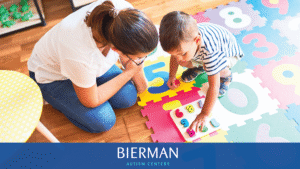To celebrate Occupational Therapy Month, Director of Occupational Therapy Maeve London, OTR/L, ASDCS, answers the question: What is Occupational Therapy for Autism?
When occupational therapy (OT) first emerged over 100 years ago, the term “occupation” referred to anything you do in your daily life that occupies your time. OTs still rely on that definition today. Occupational therapy is a health profession focusing on using everyday activities for their therapeutic potential. When a diagnosis, injury, or illness impacts a person’s ability to participate in their daily activities independently, an OT is there to help. OTs use their body mechanics and neuroscience training to identify barriers to participation and generate solutions. From eating breakfast to writing our names to throwing a ball back and forth, each activity in our daily lives requires complex and synchronized body processes. Pediatric occupational therapy is rooted in breaking activities into manageable parts and using play as a learning medium.
Here at Bierman Autism Centers, our clients have many meaningful occupations, including:
- Play
- Social participation
- Activities of Daily Living (eating, brushing teeth, dressing, toileting, grooming)
- Instrumental Activities of Daily Living (meal prep, community mobility, care of others and pets)
- Education
- Leisure
- Sleep
OTs use standardized assessments, clinical observation, and caregiver reporting to identify goals. OTs at Bierman run 25 hours of direct therapy weekly, ensuring we provide our masters-level expertise directly to client sessions. OTs work on fine motor, gross motor, feeding, hand-eye coordination, and sensory regulation. Particularly, complications with fine, gross, and visual motor may result in difficulty engaging in activities children are both expected to and would like to engage in. This is where we can start to see the frustration build. Our goal is to make those activities easier for clients using play-based strategies to target those goals.
Fine motor skills: handwriting skills, scissor skills, developmentally appropriate grasp pattern on a variety of items, completing a puzzle, grasping the sides of clothing to put on or take off, hand strength to complete fine motor tasks
Gross motor skills: throwing and catching a ball, kicking a ball, balance, and body awareness throughout play and daily activities, pulling a shirt overhead or placing both legs into the pant legs during dressing, upper and lower body strength to carry out everyday activities
Visual-motor skills: scanning and tracking during handwriting or throwing/catching a ball (eye-hand coordination), decoding visuals to locate a specific item in their environment, eye-hand coordination during fine or gross motor tasks such as bringing a spoon or fork to your mouth or building with blocks
What does an OT session look like?
Each session is catered to the individual client’s needs and preferences. If a client was working on drawing lines and had a passion for cars, an OT may have them draw the lines of a road. Another client may start their sessions with an obstacle course to target balance and coordination. When working on clothing fasteners, we may pretend we have to put on a superhero vest with buttons before we can fly to the crashpad.
Many clients come to us with restrictive diets. OTs work to systematically introduce novel foods in a way that is approachable and relies on developing neural sensory pathways to help that food to go from intimidating to familiar. This could look like feeding the food to a preferred toy, participating in food preparation, or using imaginative play: Look out, dino nugget! Don’t fall into the chocolate lake! If a client has difficulty with utensils, we often start with scooping and spearing sensory materials, transitioning to foods when those motor patterns are mastered.
OTs use standardized assessments to identify what sensory experiences our clients may be seeking or avoiding and design strategies to help them reach an equilibrium. These strategies can help regulate a child and reduce non-preferred behaviors. We all process our environment through our senses. Our peripheral nervous system inputs sensory information, and our central nervous system processes and responds to sensory information. How someone seeks or avoids sensory input makes up what we call a “sensory profile.” This sensory profile can have significant impacts on function. Some examples include:
- Visual avoider: may struggle in grocery stores
- Tactile seeker: may touch strangers and unsafe textures like broken glass; tactile seekers also tend to mouth a lot
- Vestibular seeker: may constantly be moving and climbing, difficulty to keep safe or take to restaurants
If the child is seeking that input, we let them seek it in a way that is controlled. If they are avoiding we give them strategies to avoid it safely. Headphones are a common example for those who are auditory avoidant. We all have sensory preferences that impact us. Think of the times you need to get up and take a walk, feel relieved leaving a loud restaurant or just need a hug from a loved one. These are all sensory experiences.
Outside of therapy, OTs do everything else to make those sessions great! This includes generating client-specific materials, collaborating with other professionals, meeting with parents, preparing for evaluations, researching, and completing paperwork. OT is predicated on intrinsic motivation. Our OTs will problem-solve until we find a client-specific way to target therapy goals so kids are having fun and maximizing their engagement. If you think your child may benefit from occupational therapy services, an OT is here to provide a standardized assessment and personalized goals developed in collaboration with you and your family.
Meet Maeve
Maeve has been a part of Bierman’s team since 2018. Over the last 15 years, she has worked as a registered behavior technician, special education teacher, and occupational therapist in homes, hospitals, schools, and clinics. Maeve has a passion for research, dynamic therapy, and providing clinical training. Her favorite thing about working at Bierman is our focus on play as the key to learning. She enjoys using her imagination to make each therapy session client-centered. Maeve uses her expertise in animal-assisted therapy to incorporate her assistance dog Freesia (affectionately known to clients and staff as Wheezy), into her sessions.


